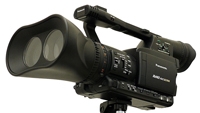2010 NAB 3-D video products in review

It was impossible at this year’s NAB Show not to notice all the 3-D offerings on the floor, and so this tutorial will take the time to provide an overview of what 3-D video products were showcased.
One of the most widely anticipated 3-D products was Panasonic’s “Wall-E” camcorder, so-called because the two lenses of the original version looked a lot like the character of the same name. Officially, it’s the AG-3DA1, a self-contained stereoscopic camcorder that uses SDHC/SD memory cards to record the dual streams of 3-D video.
By having the lenses integrated with the camera, Panasonic has eliminated one of the complexities associated with shooting in 3-D, which is keeping the two lenses synchronized in both focus and zoom. Any difference between the left and right images will distort the stereo effect and may cause viewer discomfort. Time will tell if this will become a standard maintenance function as these up-and-coming cameras age.
3-D lenses
In the lens realm, Fujinon now has a line of lenses that offers a synchronous control system. These lenses are made to a much higher optical and mechanical specifications, which enables them to more accurately track each other when used for stereoscopic capture. These lenses include a zoom controller and synchronizer/focus controller.
Stereoscopic camera rigs
When shooting high-end stereoscopic video, more flexibility in setting the 3-D parameters is usually required, and that’s where 3-D camera rigs come in. There are two basic types of 3-D camera rigs: side by side and beam splitter. Of the two, the beam splitter is more flexible, but also more costly.
Get the TV Tech Newsletter
The professional video industry's #1 source for news, trends and product and tech information. Sign up below.
One company that offers a top-of-the-line beam splitter is 3ALITY. 3ALITY’s system was used at the show during the presentations to demonstrate the parameters that need to be set up and adjusted when shooting in 3-D. The company offers several different types of 3-D camera rigs from side-by-side to beam-splitter rigs, all of which are motorized and computer controlled. The TS-2 beam-splitter rig offers a great deal of control and monitoring, making adjustments to the relationship of the two cameras as they are zoomed or refocused and compensating for optical aberrations that occur when using two lenses. In addition, the SIP 2100 stereoscopic image processor presents a display that shows in simple terms when the stereoscopic video being shot is within acceptable parameters. It can also perform color correction between cameras and provides either 2-D or 3-D monitoring outputs. 3ALITY even has an iPad interface to remotely control and monitor the rig.
A number of other companies have introduced stereoscopic camera rigs, including P+S Technik, which makes beam-splitter camera rigs and offers stereoscopic calculator software that currently runs only on Windows machines; 3D Film Factory, which makes side-by-side and beam-splitter camera rigs that are manually adjusted for professional cameras as well as DSLR and smaller camcorders; and S3D Technologies, which offers both side-by-side and beam-splitter camera rigs that are motorized and wirelessly remote controlled using their S3D 3-D calculator software.
This is not an exhaustive list of companies working on stereoscopic camera rigs, so expect plenty more to come.
3-D image processors
Another crucial part of capturing 3-D video is converting the dual streams of HD-SDI into something that can be watched in the field or studio. This is where 3-D image converters come in handy. They can accept the two HD-SDI video inputs and convert them to any of a number of output formats for viewing during production or even during editing.
A couple of these units can convert a dual stream of HD-SDI into either side-by-side, top/bottom or frame-sequential, single-stream HD-SDI, allowing it to be recorded on a single HD channel, edited and delivered that way, thus simplifying the entire 3-D workflow.
Evertz offers the 7732DVP-3D-HD image processor that accepts two 1.5Gb/s HD inputs and converts them to a 50/50 mix of left/right, difference between left/right or a horizontal split screen. A number of other adjustments can be made to the images at the same time to assist in aligning the left and right images. Evertz also has the 7832SVP-3G, provides outputs to 3-D flat-panel displays in formats including top/bottom, left/right and pixel checkerboard (for DLP displays).
DTI has the 3D Video Encoder, which works with two NTSC video inputs and converts them to a 3-D video output. The output is selectable between side-by-side or field-sequential formats for display on a 3-D monitor. Miranda makes an image processor, the 3DX-3901, that accepts several different inputs, including two (left/right) HD-SDI signals. The output of the 3DX-3901 can be anaglyph, difference or left/right eye (two separate images). And Doremi has introduced the Dimension-3D converter, which accepts a wide range of inputs and converts to any other output. Formats supported include side by side, top/bottom, alternate line, checkerboard and sequential frame as well as dual-stream HD-SDI.
Field monitors
Panasonic offers the BT-3DL2550 LCD monitor, which accepts two HD-SDI inputs directly from the stereoscopic camera(s) and displays a 3-D image. It also accepts side-by-side and alternate-line inputs and uses a polarizing filter on its screen to separate the two images. To compete, TV Logic has introduced an OLED monitor, also with two (left/right) HD-SDI inputs as well as two HDMI inputs. Again, this allows it to be used in the field to monitor 3-D productions, but this monitor requires active-shutter glasses for 3-D viewing. Still, the OLED display provides an extremely high contrast ratio and wide viewing angle.
3-D transport
Once you have the camera, rigs and 3-D monitors, you need to get the camera signals back to the truck or the studio, and there are a number of products made to do just that.
T-VIPS recommends its TVG450 JPEG 2000 gateway to compress and transport a 3-D HD signal over an IP network, and then decode it with another gateway at the other end. JPEG 2000 is used due, in part, to its low latency. Telecast has its CopperHead fiber-optic camera transceiver to get 3-D camera signals from the field to the truck. CopperHead has already been used extensively in the industry, including on big-budget projects such as “Avatar” and the 2010 World Cup. Lastly, MultiDyne offers its solution to 3-D content transport with LiGHTBoX 3D, a field fiber transport system built for use at sporting and news events.
3-D switching
Once the 3-D signal is in the studio, it needs to be switched. Following are a few examples.
Panasonic has the AG-HZ100, a two- (3-D) or four-input (HD) basic switcher small enough to use in the field. For bigger systems, Snell offers the Kahuna 360. With up to 120 inputs, it can also perform effects on the 3-D signals. Also, Grass Valley offers the Kalypso HD production switcher, which can handle up to 90 inputs and works in 3-D.
Recording 3-D
Next, it’s time to record the 3-D signals.
360 Systems has the 2020HD with dual HD-SDI inputs and outputs. Depending on the format captured, it can record from four to 10 hours without external storage. Wafian makes a series of hard disk rack-mount and field recorders, and their new HR-2-DS recorder will handle dual HD-SDI streams. Doremi’s V1-HD records dual streams of HD-SDI, and Convergent Design offers the nano3D, a small unit meant to attach to the camera and store the video on CompactFlash media. It has dual HD-SDI inputs with LTC, and for playout, it can provide dual HD-SDI streams or convert them to side-by-side, top/bottom or alternate-line formats.
Conclusion
As always happens with product round-ups, some products unintentionally have been overlooked. What were some of your favorite 3-D products at the 2010 NAB Show? Leave a comment below or start a discussion thread in our forum.
